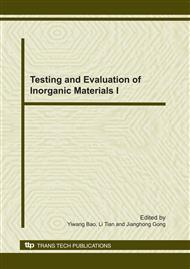p.325
p.329
p.334
p.338
p.342
p.346
p.349
p.352
p.357
The Exploring Research of the Determination Method of Magnesium Oxide Hydration
Abstract:
Magnesium oxide is one of the most important raw materials in the refractory industry due to its high melting point (2800oC), corrosion resistance in the basic environment, and low cost. Nevertheless, magnesium oxide reacts easily with water to produce magnesium hydrate, which is followed by a large volumetric expansion, limiting its application in refractory industry. As the hydration of MgO is very important either in theory or in industrial production of magnesium, in this paper, the influence of temperature, residence time, as well as the impact of the solid content on MgO hydration and the kinetics of hydration reaction was evaluated to optimize the determination method of magnesium oxide hydration in refractory industry.
Info:
Periodical:
Pages:
342-345
Citation:
Online since:
December 2010
Authors:
Keywords:
Price:
Сopyright:
© 2011 Trans Tech Publications Ltd. All Rights Reserved
Share:
Citation:


